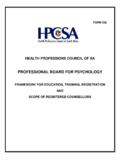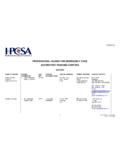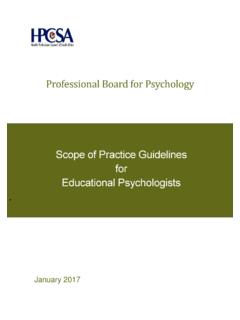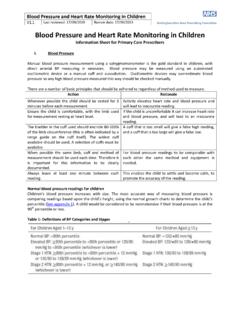Transcription of CLINICAL PRACTICE GUIDELINES - Health Professions Council ...
1 JULY 2018 CLINICAL PRACTICE GUIDELINES To All Registered Emergency Care Providers This document serves to inform all emergency care providers that the below CLINICAL PRACTICE GUIDELINES (CPGs) and related capabilities and medications have been adopted by the Professional Board for Emergency Care (PBEC) for use and implementation by all registered emergency care providers. It is the responsibility of all registered persons to a.) familiarise themselves and b.) undergo learning/training activities related to the contents of the document. In addition to familiarisation, it is important that as far as possible, and where relevant, the related CLINICAL PRACTICE guideline is used during all CLINICAL encounters.
2 Where not applicable, all reasonable, locally contextual standards of care apply to CLINICAL encounters. The deadline for the adoption of the revised list of capabilities and medications by registered persons is the 31st of December 2018. It is, however, acknowledged that the learning/training activities required to perform procedures and administer medications not currently on the scope of PRACTICE , will extend beyond this deadline. Emergency care providers are directed to the revised list of capabilities and medications which are attached as an Annexure to the GUIDELINES . The revised list of capabilities and medications (read together with the requirements linked to the performance and/or administration of such skills/medications) are applicable as per the above-mentioned deadline date.
3 It must, however, be noted that the medications not currently on the scope of PRACTICE await final regulatory approval. Further communication will follow in relation to the approval of these medications. Emergency care providers acting outside of the revised list of capabilities (and mandatory training to perform such procedures) will be considered to be acting outside of the relevant scope of PRACTICE . 2 Abbreviations ACS - Acute Coronary Syndromes AEA - Ambulance Emergency Assistant AFEM - The African Federation for Emergency Medicine AHA - American Heart Association ALS - Advanced Life Support ANT - Ambulance Emergency Technician BAA - Basic Ambulance Assistant BEMC - Bachelor s in Emergency Medical Care BLS - Basic Life Support CCA - Critical Care Assistant CEBHC - Centre for Evidence-based Health Care COPD - Chronic Obstructive Pulmonary Disease CPG - CLINICAL PRACTICE Guideline CPR - Cardiopulmonary Resuscitation EC - Emergency Care ECSSA - Emergency Care Society of South Africa ECA - Emergency Care Assistant ECP - Emergency Care Practitioner ECT - Emergency Care Technician EM - Emergency
4 Medicine EMSSA - Emergency Medicine Society of South Africa ENSSA - Emergency Nurses Society of South Africa Epinephrine - Adrenaline HPCSA - Health Professions Council of South Africa ICU - Intensive Care Unit ILCOR - International Liaison Committee on Resuscitation ILS - Intermediate Life Support IM - Intramuscular, Intramuscularly IMD - Invasive Meningococcal Disease IO - Intraosseous, Intraosseously IV - Intravenous, Intravenously ND EMC - National Diploma in Emergency Medical Care NICU - Neonatal Intensive Care Unit NIV, NPPV - Positive Pressure Non-Invasive Ventilation NSTEMI - Non-ST-Elevation Myocardial Infarction PaCO2 - Partial Pressure of Carbon Dioxide PBEC - Professional Board for Emergency Care PR - Per Rectum STEMI - ST-Elevation Myocardial Infarction SVT - supraventricular tachycardia TCA - Tricyclic Antidepressant VF - Ventricular Fibrillation VT - Ventricular tachycardia 3 Recommendations 4 Usage The following depicts the purpose of the various text boxes: Definitions: CLINICAL advice: seeking consultation with providers of an individual an individual registered as an Emergency Care Practitioner, Emergency Medicine Physician or appropriate healthcare professional (specialist).
5 PRACTICE point: Aims to guide clinicians in how to perform the recommendation in PRACTICE . Implementation point: Clarifies the context of a recommendation. Cross reference: Identifies other useful recommendations/sections. 5 1. Obstetrics & Gynaecology There were no evidence-based CLINICAL PRACTICE GUIDELINES addressing obstetric issues from a purely pre-hospital emergency services perspective. Despite this, there were many high-quality recommendations from in hospital and other types of Health facilities ( midwife run delivery units) which are directly applicable to pre-hospital management of obstetrics. The delivery and birth process will ideally not occur in the pre-hospital environment, but every practitioner needs to be able to manage a delivery and to intervene where necessary within the limits of their scope of PRACTICE .
6 Normal Delivery A normal birth is defined by the WHO as: spontaneous in onset, low-risk at the start of labour and remaining so throughout labour and delivery. The infant is born spontaneously in the vertex position between 37 and 42 completed weeks of pregnancy. After birth mother and infant are in good condition (World Health Organization, 1996). The role of the EMS practitioner is to provide comfort and support for the mother and newborn, and to monitor and assist where necessary, while transferring to the appropriate Health facility. However, an apparently low-risk normal delivery can complicate without warning at any stage, so the definition is often applied retrospectively. Healthcare professionals and other staff caring for women in labour should establish an empathetic relationship with women in labour and ask them about their expectations and needs, so that they can support and guide them, being aware at all times of the importance of their attitude, the tone of voice used, the words used and the manner in which care is provided (Australian Resuscitation Council , 2011).
7 The first stage of labour begins from the onset of labour (onset of regular labour pains) until the second stage of labour. During the first stage (lasting, on average, 5-8 hours) mothers require reassurance, comfort and support, hydration and appropriate pain relief where necessary. The second stage of labour is usually faster, commencing when the cervix is fully dilated, and the foetus is expelled. The initial passive phase precedes the active phase, where there are expulsive contractions, maternal pushing, and the foetus becomes visible. During the active phase, mothers should be encouraged to push, and the foetus supported as it emerges. In the presence of foetal distress, it may be appropriate to expedite delivery by encouraging the mother to push earlier than the recommended active phase at the end of the second stage of labour.
8 6 The third stage starts immediately after delivery of the baby and ends with delivery of the placenta. This would normally occur spontaneously within 30 minutes (Australian Resuscitation Council , 2011). The fourth stage is defined as the first hour after delivery of the placenta. The woman is at risk for postpartum haemorrhage and must be observed (National Department of Health , Republic of South Africa, 2015). Women in labour should be treated with the utmost respect and should be fully informed and involved in decision-making. To facilitate this, healthcare professionals and other staff caring for them should establish an empathetic relationship with women in labour and ask them about their expectations and needs, so that they can support and guide them, being aware at all times of the importance of their attitude, the tone of voice used, the words used and the manner in which care is provided.
9 (Australian Resuscitation Council , 2011) Evidence from non-analytical studies such as case reports and case series or expert opinion or evidence extrapolated from well-conducted cohort or case and control studies with low risk of bias and a moderate probability of establishing a causal relationship. The active method of managing the third stage is recommended, to prevent excessive bleeding: (National Department of Health , Republic of South Africa, 2015) Immediately after delivery of the baby, ensure by abdominal palpation that there is no previously undiagnosed second twin, even if antenatal ultrasound found a singleton pregnancy. If there is no second twin, immediately give oxytocin 10 units intramuscularly (IM).
10 Await uterine contraction for 2-3 minutes then feel for uterine contraction every 30 seconds. Do not massage or squeeze the uterus with the placenta still inside. When the uterus is felt to contract, put steady tension on the umbilical cord with the right hand, while pushing the uterus upwards with the left hand. Deliver the placenta by applying continuous gentle traction on the umbilical cord. Foetal distress during labour is suspected when the foetal heart rate is abnormally high or low. It should be managed as follows pre-hospital: Explain the problem to the woman. Place the woman in the left lateral position. Stop oxytocin infusion if applicable. Give oxygen by face mask at 6 L/min for 20-30 minutes.












